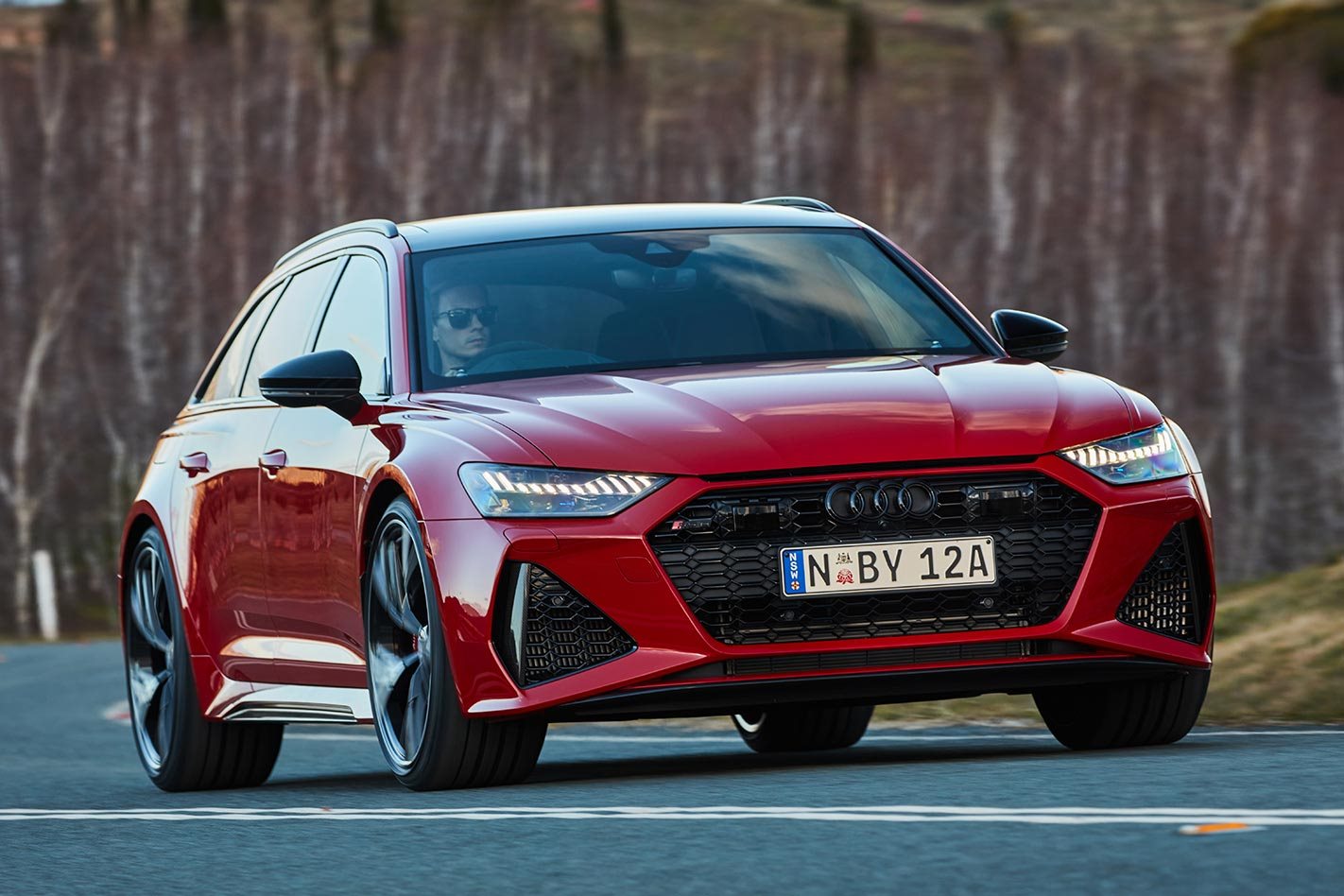The Audi RS6 Avant sits, or more accurately squats in the small Hunter Valley town of Denham, its cartoonishly huge rims already shaded with the efforts of numerous hard stops.
Its paint is battle scarred with the internal bits of a thousand insects. Its barely existent tyre sidewalls are caked in that curious ochre of dust and road grime. And yet, I am head over heels in love.
My first glimpse of Audi’s brand new uber wagon was in an abandoned Munich railway shed, polished to within an inch of its life and detailed to complete excess by its proud engineering team. But, here on a greying day in rural New South Wales, battle-grimed and primed for more, I don’t think I could love a car any more than I love the RS Avant at this moment.
I’m a modest man. My idea of being rich is to be able to use a brand new razor cartridge every time I shave. I’ve also never really gotten in with the notion of having a garage full of cars for various occasions. Hey, sure, if the world’s biggest lottery ball dropped on my yard, I’d be as flush with hot metal for every day of the week as any of you would be.

But if I found a small pocket of lithium in my backyard, and I was able to buy just one car, the RS6 Avant has always been quite near the top of the list.
Let’s check off its basics in terms of desirability. Number one: just look at the damn thing. The design language with which it’s been imbued wraps up so many elements, yet uses so few. It looks like a homologation special, yet can hold its own in the driveway of any fancy winery. It’s got muscles for days, and yet there’s also elegance and a subtlety to its finer detail.
Then we get to the mechanicals. I pine for the days when a fast Audi like the S6 was equipped with a howling V10, but, as we’ve all found in the era of the turbo, there’s no substitute for a wall of torque, and the 446kW twin turbocharged 4.0-litre V8 certainly obliges. Power is sent to all four wheels – of course – via a Torsen limited slip centre differential, distributed in normal circumstances 40:60 front-to-rear, but able to send 85 per cent torque to the rear only when the situation demands.
There is so much engineering prowess in this most unhumble package that it almost defies belief. And, the fact that Audi can pluck the very best from the Volkswagen group bins and apply them in such a clever and dedicated fashion is a credit to all of them. Those 10-piston brake calipers up front for example, are plucked from the Lamborghini Urus, while there isn’t a racecar on the planet that has bigger front brake rotors.
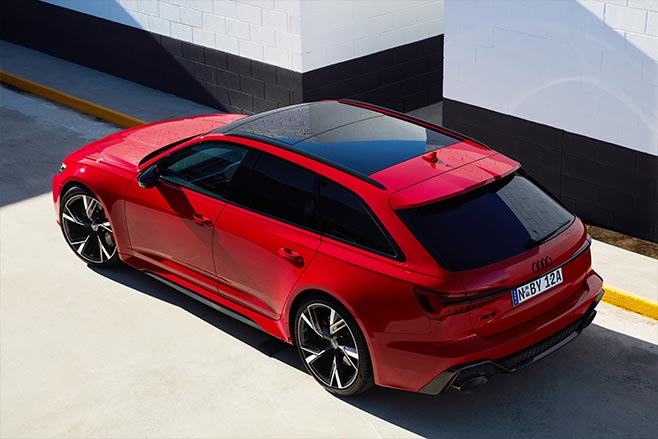
I love, too, that the RS6 can be configured in pretty much any way you like. If your mission is comfort and touring, then sir/madam may like the air-spring equipped version of the car. Should a sharper, more dynamic feel be required, then steel springs are also on the table.
Inside, the low-slung quilted leather seats are almost infinitely adjustable, and are – just – slung deep enough into the floorpan. Audi’s fit/finish and use of materials has been exemplary over the last few years, and the RS6 displays this talent everywhere you look.
Sure, some options cost as much as a secondhand A1, but to run your thumb across the raised carbon fibre inlay on the door card tells you instantly why you fell in love with this car.
That same carbon inlay extends across the centreline of the car, framed with metalwork that exudes richness and depth. No painted-on finishes aboard the RS6; it’s all the real deal.
I’m not married to the piano lacquer across the centre console, and I would opt for something that didn’t shine so brightly on summer days, but it’s a minor quibble in a truly gorgeous place to be.
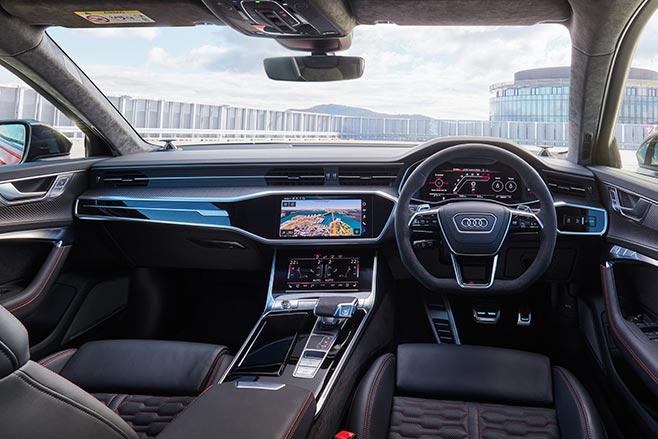
My RS6 wouldn’t have a sunroof, either; I don’t see the point with an extra 18-odd kilos perched on my head, but again, quibbles. The Alcantara steering wheel too, is a real joy and a thing of beauty to both behold and to use. Its diameter is millimetre perfect, its thumb concaves moulded just so. And it’s another reminder of just what you’ve bought.
The new MMI operating system takes a bit of getting used to, but once you’ve settled on your favourite screen displays, you really shouldn’t have to play with it too much more.
It’s a station wagon, too. Need to take the dog to the vet? Want to put a couple of pot plants in the boot? Or you might even need to tow some sort of… I don’t know, boat or something. The RS6 is more than capable of doing it all. And, what’s more, patina will suit it. The scars of day to day life will only add to this car’s portent and intent.
When you start the RS6, there’s a natural expectation of fire and brimstone given its hard-as-nails exterior visage. Index finger on the cold metal of the start button and the V8 snaps into life, but there’s no theatrics as you’d find in something like an R8. Sneak the gaming-style T bar into D and the RS6 moves off as docile as an A3. In fact, it’s quite deceptive; right from the outset, the RS6 cossets rather than corrupts, inviting you to be part of the experience and not disdainfully looking down its nose from afar as it does its truly spectacular thing.
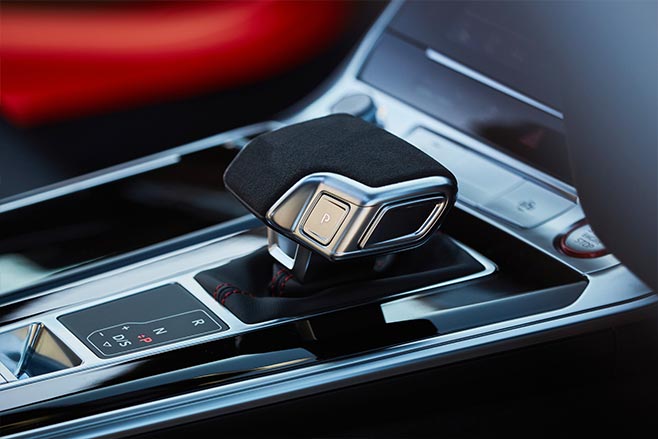
? February 2024: RS6 GT revealed as C8 swan song
Hey, it’s Wheels phoning from the future. Audi has revealed a fitting finale for its C8 RS6, dubbed RS6 GT. Read about it at the featured story link below.
Story continues…
There’s very little tyre noise intrusion from those huge 22-inch tyres, and the engine remains muted. That is, until you want to hear it.
How? The RS mode button on the right spoke of the steering wheel provides two distinct setting parameters that can be tuned to your preference. My favourite? Everything, except the dampers, turned all the way up to 11. A new, purposeful heads-up display appears in the window. The throttle is instantly much, much sharper, and the exhaust, while still relatively muted, makes its presence felt.
Knock the shifter over to the left to engage manual mode and the new polished, machined-alloy shifter paddles are a joy to use, and once more, a sign that you’ve done the right thing by splashing out on the RS6.
It’s wrong to call the RS6 a big car, but equally it’s no shrinking violet. It doesn’t contract around the driver; rather, it has the feel of something with substance, with gravitas, something that needs to be respected.
Snap open the throttle and the RS6 takes merely a moment to gather its thoughts before flinging you bodily at a future that includes the loss of your driver’s licence. The pace is absolutely relentless as you surge past 4000rpm and does not give up until it’s whamming into the 7250rpm redline.
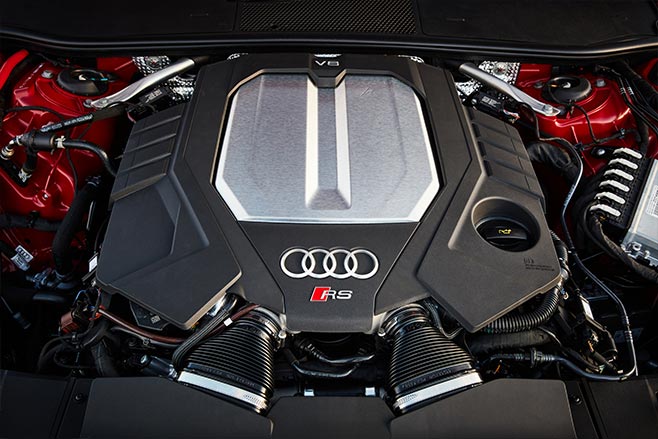
You pull a paddle and again, you are catapulted at the horizon. Audi claims the gearing set aboard the RS6 means you can see 330km/h should you so desire, and I have no doubt that the RS6 could nail that every day of the week.
The chassis tune is interesting. There’s no semblance of kidney-belting stiffness; rather, there’s compliance and a sophistication that aids the cause of speed, rather than holding you back. The rear end squats hard under the burden of 800Nm of torque but the balance remains neutral, and there is a surprising amount of steering feel under your fingers as the 285mm wide tyres hunt for grip.
The Dynamic pack brings steel springs and diagonally linked dampers, tied in with all-wheel steering that adds point and surprising delicacy to the front end. The reduced mass of a V8 over the C6 version’s twin-turbo V10 makes more sense, and the RS6 has the handling chops to match its sky-high outputs. With those 10 pistons clamping each 420mm front brake rotor, you’re never shy of stopping power.
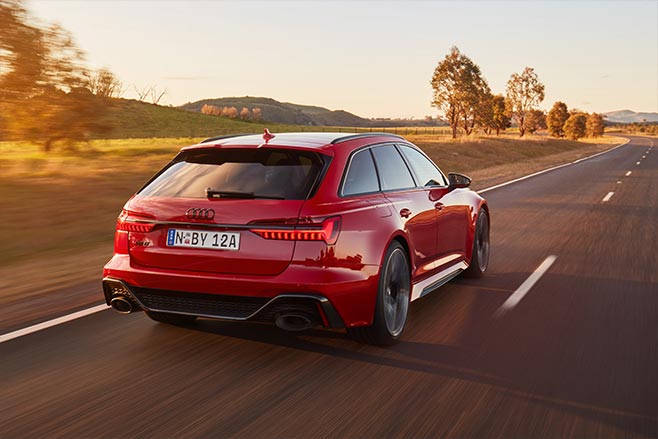
Despite its $216,000 price-tag, I want this car in my garage, and no others… well, with a registration plate anyway. It can tow, it can lug stuff, it can devour the gaps between towns, and it can slay back roads. It lacks the final dynamic thrills of something like an R8, but equally you can barely put a bottle of water in Audi’s V10 supercar.
There’s very little that the RS6 Avant can’t do, and when you look at it under that light, it’s almost a bargain.
Pros: Saturn V-rivalling acceleration; comfort; usability Cons: Two tonnes and 5m length can only hide for so long
4.5 stars out of 5
2020 Audi RS6 Avant specs Body 5-door, 5-seat wagon Drive all-wheel Engine3996cc V8, DOHC, 32v, twin-turbo Bore x stroke 86.0 x 86.0mm Compression 10.0:1 Power 441kW @ 6000-6250rpm Torque 800Nm @ 2050-4500rpm Power/weight 212kW/tonne Transmission 8-speed automatic Weight 2075kg Suspension Multi-links, air springs, adaptive dampers (f/r) L/W/H 4995/1951/1487mm Wheelbase 2930mm Tracks 1668/1650mm (f/r) Steering Electrically assisted rack-and-pinion; rear steering Brakes 420mm ventilated/drilled discs, 10-piston calipers (f); 370mm ventilated/drilled discs, single-piston calipers (r) Wheels 22.0 x 10.5-inch (f/r) Tyres 285/30 R22 101Y (f/r); Pirelli P-Zero Price $216,000
Audi RS6 Avant: MOTOR’s first international drive
MARK TISSAW | FEB 2 2020
The Audi RS6 has always felt like the Audi Sport flagship. The RS6’s bonkers past most famously includes a V10 engine and has amusingly mixed supercar-baiting performance with practicality over four generations now.
You’ll recognise plenty about this new RS6 from its RS7 sibling, and we’ve come to the US to test it because, surprisingly, it’s the first time the RS6 has been sold here.
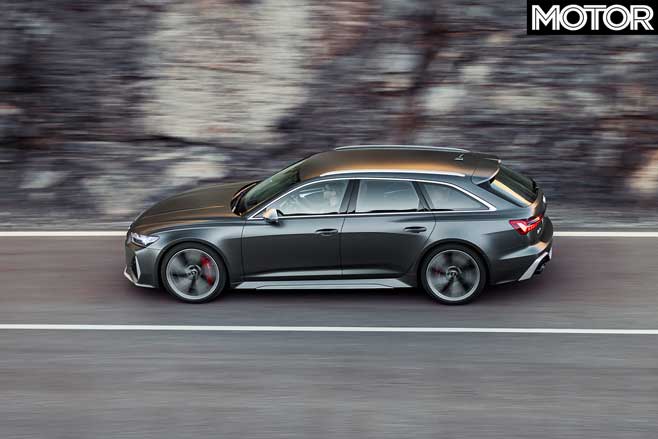
Even by Californian standards, the styling is no shrinking violet and quite a change over the classy A6 Avant. Only the roof, front doors and tailgate are carried over, with every part sculpted to look more aggressive, most notably the flared wheelarches (housing wider tracks and bigger alloys), bonnet, rear spoiler, and front and rear bumpers. It looks more like a GT3 car than an estate with some of the addenda – and, to these eyes, it’s brilliant.
Whereas the RS4 has switched to a V6, a V8 is retained in the RS6 – and significantly upgraded with a larger turbo and increased boost pressure. The twin-turbo 4.0-litre produces a colossal 441kW at 6000rpm and 800Nm from 2050-4500rpm and is hooked up to an eight-speed tiptronic auto and a proper Torsen differential-based permanent four-wheel drive. There’s also a torque-vectoring diff at the rear.
The engine itself is now a mild hybrid, mated to a 48V system to boost energy recuperation. It works for efficiency reasons only rather than performance, not that the RS6 is wanting in the performance stakes: 0-100km/h takes a claimed 3.6sec, traction off the line aided by a new launch control system.
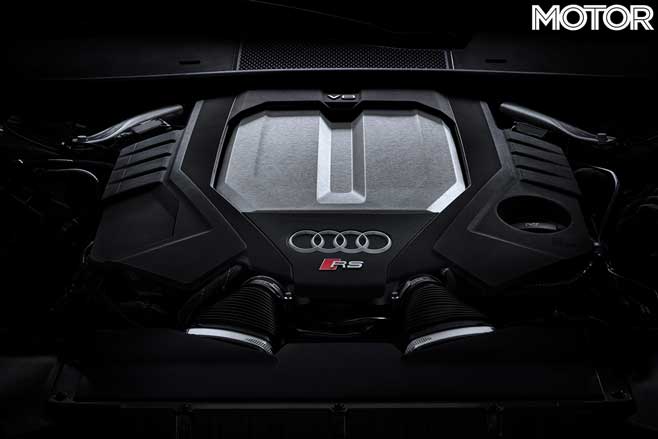
Height-adjustable adaptive air suspension is standard, the car sitting 20mm lower than the A6 Avant. Steel coils with an interconnected hydraulic damping system is included on the range-topping version. Active all-wheel steering from the RS7 features, as does the option of ceramic brakes.
There are fewer changes inside, and less added aggression. The seats (very comfortable and supportive) are new, as is the steering wheel, which has larger shift paddles, but the capaciousness of the standard A6 Avant remains. Fido should be kept happy by the 565-litre boot, rising to 1680 litres with the 40/20/40 split rear seats folded flat.
Two customisable driving modes (RS1 and RS2) allow you to pick out the best bits of the standard Comfort, Auto, Dynamic and Efficiency modes that tweak all major dynamic components. In the RS2 mode, you can also now turn off the electronic chassis control systems for the first time in an Audi RS model.
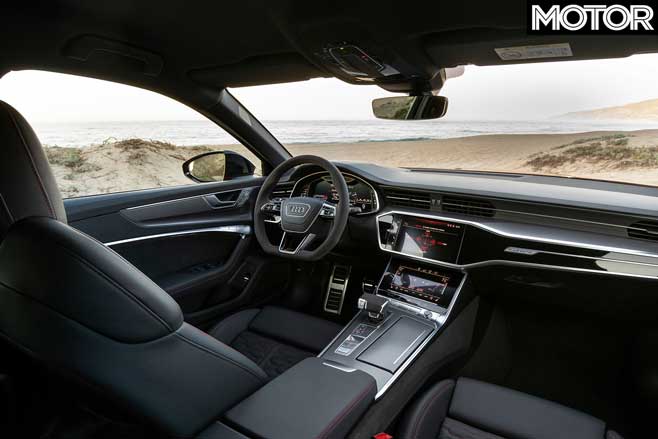
With such an extensive and complex specification – there are more than 40 ECUs talking to one another – it’s surprising that it is so relaxing, comfortable and easygoing as you roll down the road for the first time. You’re almost left wondering if you’re driving the same aggressive-looking car you stepped into, such is its refined manner, which leans more towards comfort than sporty.
On air suspension, the ride is reasonably quiet and cushioned, and even with large 22in alloys it manages all but the largest road scars and abrasions well, those firmer abrasions causing the body to rock.
The sports exhaust, even in the Dynamic mode, is fairly quiet and certainly doesn’t scream 600 horsepower – until you really squeeze the throttle and the RS6’s considerable straight-line pace is revealed. It’s not sledgehammer in its delivery in the way that a Mercedes-AMG is, nor raucous in the way of an Italian or British V8, but it’s supremely fast nonetheless.
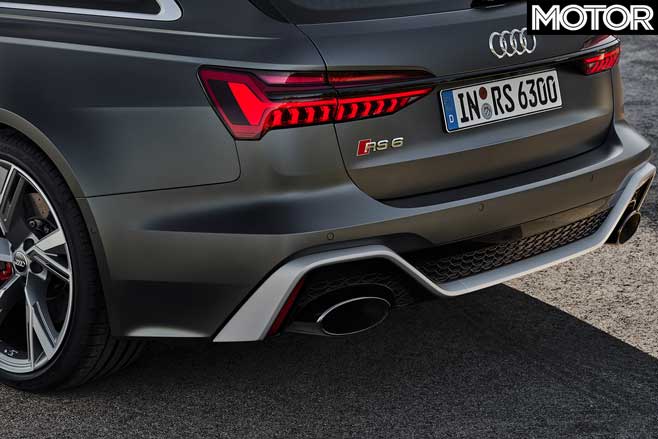
The refinement at low speeds isn’t lost when you push on either. The engine is extremely flexible and happy to be revved all the way to the redline, and on a wide-open throttle finally exhibits aural charm, albeit not at the levels of an AMG V8. It’s your eyes rather than your ears that let you know how brisk your progress really is.
On tighter roads, you can happily use just second and third gear, such is the wide spread of torque and drivability, but gearshifts, whether manual or automatically controlled, aren’t the event they could be, even in the crispest shift mode. The quiet, efficient shift is a good metaphor for the drivetrain as a whole: the RS6 is a machine that likes to make progress in a rapid but ultimately fuss-free way.
It’s much the same for the chassis, which is improved over the previous RS6. It turns in more keenly and feels a good deal nimbler, the four-wheel steering at work here. Yet its sheer size and weight mean it never feels fully at home in slow corners and twisty roads in the way it does in faster, flowing ones. Nor does it ever really exhibit much feel through your hands or backside.
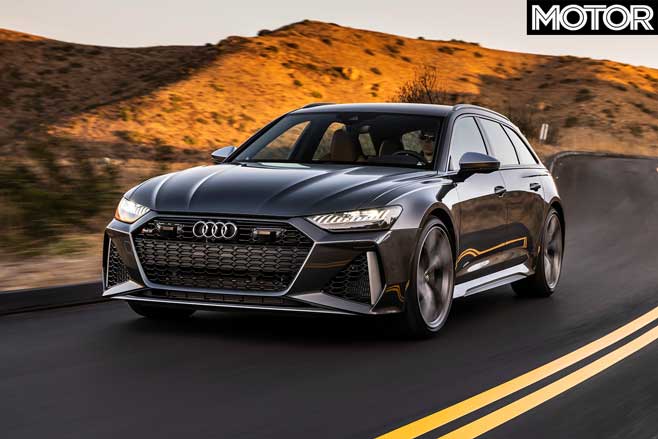
That sense of feel is improved with steel coils, but lacked the air’s suppleness and ride comfort. Whatever the version, there’s a lingering doubt that the RS6 may just be just too big and too complex to get anywhere near the limit of its abilities.
Still, the RS6 is probably the most usable all-round performance car on the market, especially when it’s wet and cold. There aren’t many things with this much power that you’d rather use in those conditions.
When you floor the throttle midway through a corner towards the exit, the diff tucks the rear end in, which adds to the confidence and trust you feel to get on the power early and for the car to find traction, albeit without that involvement. You’d have to be really pushing it to see the RS6’s playful side and even then it’s not a car that eggs you on to do so or really involves you in the process.
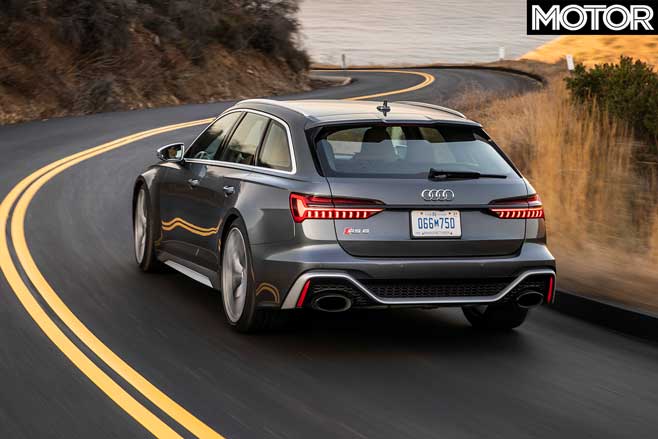
The RS6 is a car that impresses rather than excites you, and its key calling card is its sheer breadth of abilities, not just performance ones. Remember, this is a vast wagon that weighs more than two tonnes but has mighty yet undramatic straight-line and point-to-point pace, as well as space for all your stuff and brilliant, relaxed road manners for the 95 per cent of drives when you just want to blend in and get where you’re going.
Direct rivals – like the BMW M5, Mercedes-AMG E63 Estate and Porsche Panamera Turbo Sport Turismo – feel more engaging and have greater driver appeal, yet the RS6 feels more usable for more of the time and as such arguably makes for the more compelling ownership proposition. Which Audi would probably take, not only for the RS6 but also for all the new era of Audi Sport models to follow.
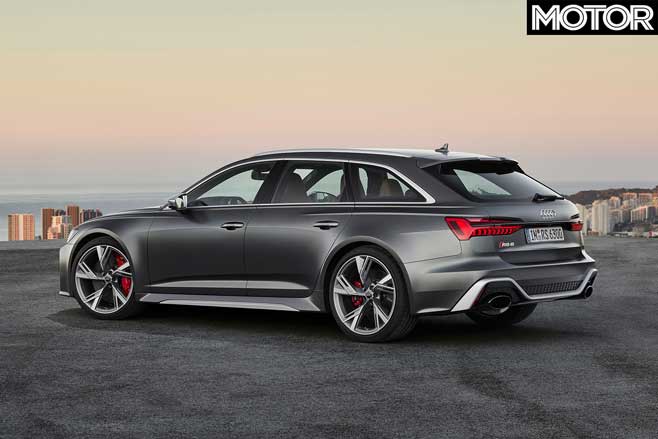
The Nemesis
Mercedes-AMG E63 S Estate 4.0-litre twin-turbo V8, RWD, 375kW/700Nm, 0-100km/h 4.0sec, 1725kg, $163,070

Gives away some useability points with its smaller cargo area, but remains the choice for those wanting to carry a load without compromising performance.

